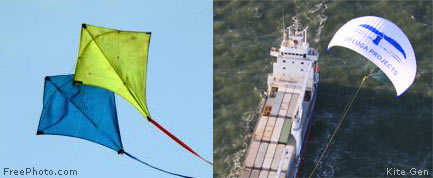How Kites Could Power the Future

Editor's Note: Each Wednesday LiveScience examines the viability of emerging energy technologies — the power of the future.
Tie one end of a string to a piece of fabric and you have a kite; but tie the other end to a generator and you have a source of electricity.
Although it can only turn a generator during part of its flight, a kite can reach the strong winds at high altitude with less fuss than a traditional wind turbine.
"The main reason to go to kites is that wind turbines require a lot of material," said Moritz Diehl from the Catholic University (K.U.) of Leuven, Belgium. "By saving on parts, kites can be more economical."
Diehl thinks the cost of electricity from kites could be a quarter of what it is from wind turbines.
Trading torque for tension
One factor in making use of the wind is knowing that its force becomes stronger the faster an object moves relative to it.
Sign up for the Live Science daily newsletter now
Get the world’s most fascinating discoveries delivered straight to your inbox.
For this reason, the tips of a wind turbine — which typically move 8 to 10 times faster than the wind speed — experience the most force. This strong tip-force creates a torque that turns the turbine's electric generator.
"The rest of the construction [the inner part of the rotor and the tower] is just there to support the tips," Diehl told LiveScience.
A kite can capture the same wind force without needing the costly support structure. This is because it transmits the force not through a torque but through the tension in the kite line.
However, like a turbine's tip, more force can be had if the kite is moving quickly relative to the wind. Diehl and his colleagues have modeled power-generating kites and shown that it is possible to steer them in a kind of figure-8 pattern that increases the force by a factor of 100 more than remaining still.
Pumping
The researchers have also shown that the optimum way to unfurl the kite line is at one-third the speed of the wind. This allows electricity to be generated from the turning spool, while keeping the kite at a fairly constant altitude of around 1300 feet (400 meters).
Of course, this can only work for a short time before the line runs out and the kite needs to be reeled back in. Diehl realized a few years ago that the amount of energy expended during reeling-in could be reduced by angling the kite's nose down.
By continuously "pumping" the kite out and in, out and in, Diehl's group has shown that 5 megawatts of power — typical of modern wind turbines — can be generated from a 500-square-meter kite (5400-square-foot) with a line 1.3 kilometers (0.8 miles) long.
In each pumping cycle, there would be 16 seconds of power generation while unfurling and 4 seconds of down-time while reeling-in.
Besides having lower material costs than traditional wind turbines, Diehl said that kites can reach higher altitudes where the wind is stronger and more constant.
Changing tacks
There are other ideas on how to generate energy from kites.
One group at Delft University of Technology in the Netherlands has proposed stringing a large number of kites along a circular line that would extend 6 miles (10 kilometers) into the sky. The whole system would turn like a waterwheel, as the kites would change tilt to go up or come down. Called the Laddermill, it could generate 100 megawatts of electricity, the researchers estimate.
An Italian company called Kite Gen has a similar idea, but with the "wheel" laid flat on the ground. The design calls for several kites attached to a kilometer-wide spinning carousel. The tilt of each kite could be controlled so that it only pulls on the carousel at specific points in the rotation.
For now, though, both the Delft group and the Kite Gen engineers have prototypes based on Diehl's pumping that can generate a few kilowatts of electricity.
Diehl also suspects Makani Power, which received $10 million last year from Google, is developing a similar sort of kite technology in relative secrecy.
It is also worth noting that kites are being used to tow cargo ships. In two demonstrations this year, Germany-based SkySails has shown that its kites can reduce fuel usage by 20 percent.
Blowing in the wind
Despite being "a fascinating and exciting idea," many technological hurdles remain for power-generating kites, said Manfred Morari, head of the Automatic Control Laboratory at ETH Zurich in Switzerland.
For one, the kites are inherently unstable. Researchers are developing automatic controls that can use data from sensors on the kite to correct for wind changes that blow the kite off course.
Another problem is scaling up systems so that they can be commercially viable.
"The kites must become bigger and bigger," said Bernhard Hoffschmidt of the Solar-Institute Jülich at Aachen University in Germany. "This will probably create problems on materials and life time."
Still, Hoffschmidt thinks that simple kite systems could be ideal for difficult locations, such as offshore.
"One of the major problems for offshore wind parks today is the needed time of excellent weather to install the units," Hoffschmidt said. Kites, on the other hand, could be installed on anchored buoys, "which can easily be installed and de-installed with a lower environment impact."
- Video: Wind-Powered Town










